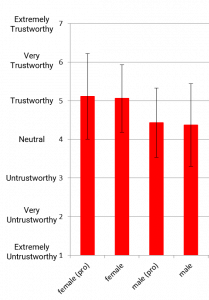We’re often asked whether there’s any reason to prefer a male or female explainer video narrator for tech-oriented videos. Our answer has always been “not really.” However, Ben Lebay, a researcher at ConversionXL.com, has published a nice study of the perceived “trustworthiness” of male and female narrators, professional and non-professional. It’s called Which Type of Voice Actor Should You Use for Your Explainer Video? — which piqued my interest, of course.
Women narrators more “trustworthy”

Not to keep you in suspense, Ben’s study found that the women’s voices were considered more trustworthy, with the professional having a slight edge. As far as I can tell, the study was statistically valid and well-designed. The samples being compared were less persuasive. For one thing, the “professionals” were from Fiverr. Real professional voiceover talent gets upwards of $300 for a two minute video — and deserves it.
If an explainer video is actually explaining something, the narrator should be describing action taking place on-screen. There needs to be something visual to be trustworthy about. The example used in the study kicked off with pretty humdrum visuals that did little or nothing to help out the narrator. Direction is also important. We direct all recordings of our videos, with attention to the cadence of every phrase and how every word is pronounced. I know what it’s to sound like. Each “scene” (scripts are divided into 15 or so scenes) is recorded several times until we get exactly the right reading. It usually takes about 30 minutes to record two minutes of audio narration.
Sex sells
Lebay cites a 2006 UNC study of “speaker persuasiveness” (Zanbaka, et. al.) which found that
Male participants were more persuaded when the speaker was female than when the speaker was male, whereas female participants were more persuaded when the speaker was male than when the speaker was female.
This makes sense, and is worth considering if your customers are mostly men or mostly women. It may also be true that a particular product or solution might seem more appropriate for a male or female voice.
One video. Two narrations.
Here is an excerpt from the same 2-Minute Explainer video recorded by two first-rate professional narrators, one male, one female. Which do think makes the better argument for the technology solution being explained?
There’s evidence that you should choose a female explainer video narrator because she’ll be more persuasive. But the professionalism of the narrator, the product, and the audience are important variables.
Some feel that technical subjects are best narrated by male voices because the tech industry is male dominated.



